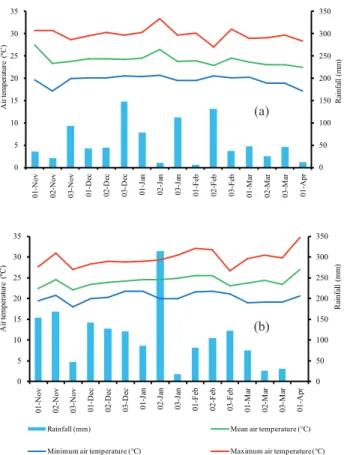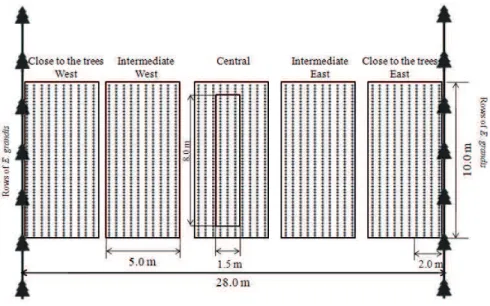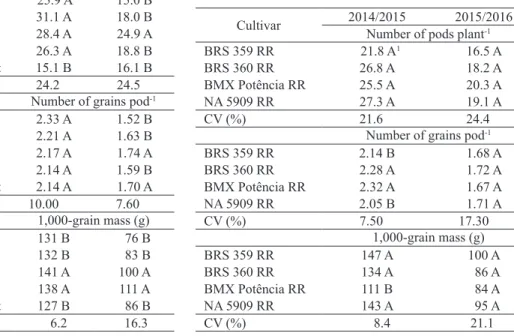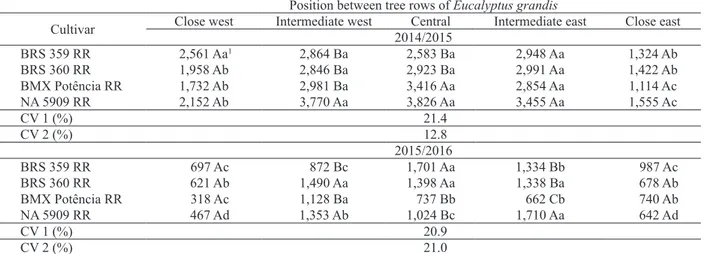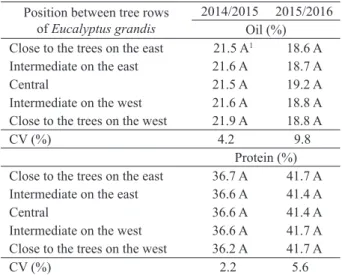Agronomic performance of
soybean cultivars in an agroforestry system
1Flávia Werner2, Alvadi Antonio Balbinot Junior3,
Julio Cezar Franchini3, André Sampaio Ferreira2, Marcelo Augusto de Aguiar e Silva2
INTRODUCTION
The increasing demand for food, fibers and agro-energy, along with production upscaling, search for practical solutions in production processes and advancement in mechanization, have transformed modern agricultural activities into simplified and standardized systems. However, this model has been considered insufficient and has shown signals of saturation, because of excessive demands for energy and natural resources, which elevate production costs and increase risks of economic failure (Reynolds et al. 2007, Balbino et al. 2011, Nair 2011, Pezarico et al. 2013).
ABSTRACT
RESUMO
In this context, the only viable alternative is to use efficient production systems that take advantage of the available resources in agrosystems and, simultaneously, improve soil quality, which is the basis for all animal or vegetable production. Such systems can reduce the consumption of inputs and generate more income in a given space (Balbinot Junior et al. 2009, Paciullo et al. 2011). Integrated systems can contribute to the soybean production sustainability in different regions of Brazil, making them an option for increasing and diversifying the producer income, as well as for further improvement of no-tillage systems (Debiasi & Franchini 2012).
1. Manuscript received in Mar./2017 and accepted for publication in Aug./2017 (http://dx.doi.org/10.1590/1983-40632016v4745937). 2. Universidade Estadual de Londrina, Centro de Ciências Agrárias, Departamento de Agronomia, Londrina, PR, Brasil.
E-mails: flawerner6@gmail.com, andresampaioferreira@gmail.com, aguiaresilva@uel.br.
3. Empresa Brasileira de Pesquisa Agropecuária (Embrapa Soja), Londrina, PR, Brasil. E-mails: alvadi.balbinot@embrapa.br,
Combining forest and crop species into a production system may enhance its sustainability. This study aimed to evaluate the yield components, yield and grain quality of soybean cultivars, in an agroforestry system containing Eucalyptus grandis. A complete randomized block design, in a split-plot arrangement, with three replications, was used. Four soybean cultivars were allocated into the plots (BRS 359 RR, BRS 360 RR, BMX Potência RR and NA 5909 RR). The subplots consisted of five positions between the rows of E. grandis
(spaced in 28 m - close to the trees on the east and west sides, intermediate position on the east and west sides and at the center of the row). The yield components and soybean grain yield reduce significantly the closer the plants are seeded to the rows of E. grandis. However, the oil and protein contents in soybean grains are not influenced by the position between rows, regardless of the cultivar. Among all evaluated cultivars, NA 5909 RR presents the best agronomic performance in the agroforestry system containing eucalyptus.
KEYWORDS: Glycine max L. Merrill; Eucalyptus grandis Hill ex. Maiden; grain quality.
Desempenho agronômico de
cultivares de soja em sistema agroflorestal
O consórcio de espécies florestais e agrícolas pode contribuir para a intensificação sustentável dos sistemas de produção. Objetivou-se avaliar os componentes de rendimento, a produtividade e a qualidade de grãos de cultivares de soja, em sistema agroflorestal com Eucalyptus grandis. O delineamento utilizado foi o de blocos completos casualizados, em parcelas subdivididas, com três repetições. Nas parcelas, foram alocadas quatro cultivares de soja (BRS 359 RR, BRS 360 RR, BMX Potência RR e NA 5909 RR) e, nas subparcelas, cinco posições entre os renques de E. grandis (espaçados em 28 m -
próximo às árvores nas posições leste e oeste, posição intermediária nos lados leste e oeste e no centro do entre renque). Os componentes de rendimento e a produtividade de grãos de soja apresentam redução acentuada quando cultivadas mais próximas dos renques de E. grandis, entretanto, os teores de óleo e proteína nos grãos não são alterados pela posição entre renques, independentemente da cultivar. Dentre as cultivares avaliadas, NA 5909 RR apresenta o melhor desempenho agronômico em sistema agroflorestal com eucalipto.
During the last decade, integrated systems combining soybean and cattle raising have significantly increased in Brazil, presenting economic and environmental advantages (Vilela et al. 2011). However, the insertion of soybean crops into agroforestry systems is still at its initial stage, given the lack of adequate technology for cultivating crops in association with trees. On one hand, rows of trees reduce the temperature spikes and wind speed in crops, minimizing evapotranspiration (Singh et al. 2012, Udawatta et al. 2014), as well as efficiently conserving soil and water. On the other hand, trees may compete for environmental natural resources such as water, light and nutrients, which, in turn, may reduce oleaginous growth and production. In general, little information has been provided regarding the variability among commercial cultivars with different genetic bases, as well as concerning their capacity to adapt to agroforestry environments (Franchini et al. 2014). Furthermore, the impacts of trees on the contents of protein and oil in soybean are still unknown.
This study aimed to evaluate the yield components, yield and grain quality of soybean cultivars in an agroforestry system with Eucalyptus
grandis.
MATERIAL AND METHODS
The experiments were conducted in Londrina, Paraná state, Brazil (23º48’S, 50º98’W, 500 m a.s.l., Cfa Köpen-Geiger climate, Rhodic Eutrudox soil type, USDA), during the 2014/2015 and 2015/2016 growing seasons. Formerly, analyses of the 0-20 cm soil layer showed the following results: organic matter = 25.5 g dm-3; pH (CaCl
2) = 5.5;
P (Mehlich) = 19.2 mg dm-3; K = 0.62 cmol
c dm
-3;
Ca = 5.6 cmolc dm-3; Mg = 1.7 cmol
c dm
-3; CEC
saturation per basis = 65 %. The experiments were conducted in the same location for both growing seasons. The data regarding rainfall and minimum, average and maximum air temperatures, during the research period, are shown in Figure 1.
At the location of the experiment, there were nearly 250 E. grandis trees ha-1, averaging 5 years of
age, 15 m of height, pruned at 6 m, arranged in simple rows allocated in level, with a 28-m space between rows. Since the agroforestry system was implemented in 2010, the area has been grown under no-tillage, rotating soybeans, corn, wheat and black oat.
Soybean seeds were sown on November 20 (2014) and November 27 (2015). Prior to sowing, the seeds were treated with Carboxin (30 g a.i. 50 kg-1
of seeds) and Thiram (30 g a.i. 50 kg-1 of seeds)
and inoculated with Bradyrhizobium elkanii, at a concentration of 5 x 109 colony forming units per
mL, in a 100-mL dose per 50 kgof seeds. In the base fertilization, 350 kg ha-1 of the formulation 0:20:20
(Embrapa 2011) were applied at the sowing furrow. Plant density and spacing were 350,000 plants ha-1
and 0.5 m, respectively. Disease, pest and weed controls were performed according to technical indications for the crop (Embrapa 2011).
The experimental design was a randomized complete block, with three replications, in a split-plot scheme. In the plot, four modern soybean cultivars of undetermined growth type were allocated. The cultivars were BRS 359 RR, BRS 360 RR, BMX Potência RR and NA 5909 RR, which contain relative maturity groups of 6.0, 6.2, 6.7 and 5.9, respectively. Between the rows of E. grandis, five
soybean-0 5 10 15 20 25 30 35 0 50 100 150 200 250 300 350 01-N ov 02-N ov 03-N ov 01-D ec 02-D ec 03-D ec 01-Jan 02-Jan 03-Jan 01-F eb 02-F eb 03-F eb 01-M ar 02-M ar 03-M ar 01-A pr A ir t em pe ra ture (º C) R ain fa ll ( mm) A.
Figure 1. Rainfall (mm) and maximum, average and minimum air temperatures (ºC), during the soybean development in the 2014/2015 (a) and 2015/2016 (b) growing seasons, in Londrina, Paraná state, Brazil.
0 5 10 15 20 25 30 35 0 50 100 150 200 250 300 350 01-N ov 02-N ov 03-N ov 01-D ec 02-D ec 03-D ec 01-Jan 02-Jan 03-Jan 01-F eb 02-F eb 03-F eb 01-M ar 02-M ar 03-M ar 01-A pr A ir t em pe ra ture (º C) R ain fa ll ( mm)
Rainfall (mm) Mean air temperature (°C)
Minimum air temperature (°C) Maximum air temperature (°C)
B.
seeding positions were considered in the subplots [close to the trees on the east and west sides (2.0 m), intermediate on the east and west sides and central]. The subplots were 10-m long and 5-m wide (50.0 m2).
The evaluations were carried out in an area of 12 m2
(8.0 m x 1.5 m) per subplot (Figure 2).
Soybean yield was determined by sampling plants within the floor area of each subplot, in which the data were corrected for 13 % humidity and expressed by kg ha-1. Ten plants were collected
sequentially in each subplot for assessment of plant height, number of pods per plant, number of grains per pod and 1,000-grain mass.
Protein and oil contents in the samples were determined by assessing intact soybeans, using the Near Infrared Spectroscopy (NIR) technique (Heil 2010). The intact and clean grains from each sample were submitted to readings in an Antaris II FT-NIR Analyzer (Thermo Fisher, EUA), containing an integrating sphere of 4-cm resolution, an average of 32 scans and background at each reading. Mathematical models, developed by the Embrapa Soja, in 2011/2012, were used for predictions of protein [180 standards, coefficient of correlation (r) = 0.97, standard error of calibration (RMSEC) = 0.64] and oil (170 standards, r = 0.98, RMSEC = 0.45).
The data were analyzed for normality and homoscedasticity by the Shapiro-Wilk and Hartley tests, respectively. The data were, subsequently, submitted to analysis of variance (Anova). Multiple comparisons of means were made by the Scott-Knott
test at p ≤ 0.05. These statistical analyses were performed using the Sisvar software (Ferreira 2011).
RESULTS AND DISCUSSION
In both growing seasons, no interaction was observed between cultivars and plant positions within tree rows for yield components. In the 2014/2015 growing season, the number of pods per plant was lower for plants located near the east trees. Conversely, in the 2015/2016 growing season, highest values for this variable were found in the central location between tree rows (Table 1). Therefore, the environment had a great influence on the number of pods per plant (Kantolic & Slafer 2007). The number of grains per pod showed no variation with position within tree rows in the 2014/2015 growing season, with expected results for the cultivars evaluated (about 2 grains pod-1) (Ferreira et al. 2016). In
2015/2016, plants located in the central position presented a higher number of grains per pod than did the other positions, however, with no difference, if compared to plants located near the east trees.
In both growing seasons, the 1,000-grain mass reduced from the center toward the tree rows. The environment had less influence on this variable than on the number of pods per plant (Ferreira et al. 2016). Nevertheless, under severe interspecific competition, as seen here, grain filling may be limited, resulting in lower grain mass values.
The yield components (number of pods per plant and 1,000-grain mass) reduce the closer to the
tree rows the soybeans are, due to the competition for light, water and nutrients (Franchini et al. 2014). The plants situated under the tree canopy are submitted to low available luminosity, what reduces the stomatal opening and, in turn, reduces perspiration and CO2 fixation. Therefore, the ratio between internal and external CO2 concentration increased, due to the low photosynthetically active radiation (Ding & Su 2010). With light absorption reduction, the photosynthesis photochemical phase, electron transport chain and biochemical phase - when CO2 is converted into sugars - are all impaired (Mendes et al. 2013). Decreasing the photoassimilate production, the vegetative and reproduction growth are debilitated, reducing the formation of new leaves, pods and grains. Additionally, the trees may compete for water and nutrients, depriving the soybean of these fundamental resources, which are necessary for growth and formation of the yield components (Franchini et al. 2014).
There was an isolated effect of cultivars for the number of grains per pod and 1,000-grain mass in the 2014/2015 growing season (Table 2). The number of grains per pod was higher for the BRS 360 RR and
BMX Potência RR cultivars (Table 2). The grain mass was lower for the BMX Potência RR cultivar. In 2015/2016, no difference was found between the cultivars for the yield components evaluated.
The interaction between the studied factors occurred for yield in both growing seasons. In the 2014/2015 season, for all cultivars evaluated, the positions closest to the trees were the least productive ones (Table 3). This effect seems to be due to the competition for resources imposed by the trees. At intermediate positions (west and central), BRS 359 RR and BRS 360 RR presented the lowest yield results, while NA 5909 RR presented the highest yield results, showing the better adaptation of the latter to this environmental condition. Thus, NA 5909 RR may reach a satisfactory yield in this type of system, when compared to the other cultivars. These results show the need for a plant-breeding program to develop new soybean cultivars adapted to growth under sub-forest conditions.
In the 2015/2016 growing season, the positions closest to the trees, for all cultivars, also provided the lowest yield (Table 3). These results once again suggest that competition with eucalyptus impairs the soybean development and, consequently, limits yield, even under atmospheric conditions favorable
1 Means followed by the same capital letter in the column do not differ by the
Scott-Knott test (p ≤ 0.05).
Position between tree rows of Eucalyptus grandis
2014/2015 2015/2016 Number of pods plant-1
Close to the trees on the east 25.9 A1 15.0 B
Intermediate on the east 31.1 A 18.0 B
Central 28.4 A 24.9 A
Intermediate on the west 26.3 A 18.8 B Close to the trees on the west 15.1 B 16.1 B
CV (%) 24.2 24.5
Number of grains pod-1
Close to the trees on the east 2.33 A 1.52 B Intermediate on the east 2.21 A 1.63 B
Central 2.17 A 1.74 A
Intermediate on the west 2.14 A 1.59 B Close to the trees on the west 2.14 A 1.70 A
CV (%) 10.00 7.60
1,000-grain mass (g) Close to the trees on the east 131 B 76 B Intermediate on the east 132 B 83 B
Central 141 A 100 A
Intermediate on the west 138 A 111 A Close to the trees on the west 127 B 86 B
CV (%) 6.2 16.3
Table 1. Number of pods per plant, grains per pod and 1,000-grain mass in different positions between the rows of
Eucalyptus grandis (average of four soybean cultivars), in the 2014/2015 and 2015/2016 growing seasons.
1 Means followed by the same capital letter in the column do not differ by the
Scott-Knott test (p ≤ 0.05).
Cultivar 2014/2015 2015/2016
Number of pods plant-1
BRS 359 RR 21.8 A1 16.5 A
BRS 360 RR 26.8 A 18.2 A
BMX Potência RR 25.5 A 20.3 A
NA 5909 RR 27.3 A 19.1 A
CV (%) 21.6 24.4
Number of grains pod-1
BRS 359 RR 2.14 B 1.68 A
BRS 360 RR 2.28 A 1.72 A
BMX Potência RR 2.32 A 1.67 A
NA 5909 RR 2.05 B 1.71 A
CV (%) 7.50 17.30
1,000-grain mass (g)
BRS 359 RR 147 A 100 A
BRS 360 RR 134 A 86 A
BMX Potência RR 111 B 84 A
NA 5909 RR 143 A 95 A
CV (%) 8.4 21.1
to oleaginous plants (Figure 1). At the intermediate west position, BRS 360 RR and NA 5909 RR reached the highest yield. Yet in the central position, BRS 360 RR and BRS 359 RR reached the best results, when compared to the other cultivars. For the intermediate east position, the only significantly different cultivar was NA 5909 RR, with the highest yield.
Franchini et al. (2014) also observed a high negative impact of eucalyptus tree rows on soybean yield. However, the authors did not study which were the most impacting environmental factors (light, water or nutrients) on the interspecific competition between soybean and eucalyptus.
Whereas rainfall was adequate in both growing seasons for soybean (Figure 1), as well as soil fertility and fertilization were adequate for cropping (Embrapa 2011), the competition for light, exerted by the eucalyptus, seems to be the main factor limiting the achievement of the production potential of soybean cultivars. The soybean plant fixates carbon through a C3 cycle, presenting a low luminous efficiency and a high light compensation point. Therefore, relatively high quantities of light are required to produce photoassimilates (Casaroli et al. 2007). When luminosity is lower than the luminous compensation point, the oxidation of carbon by cellular respiration overcomes the carbon fixation by photosynthesis, reducing the net photosynthesis rate and, consequently, the dry matter production. On the other hand, the soybean plant is relatively tolerant to adverse atmospheric conditions, especially during its vegetative period. It presents a good recovery
capacity, though high yield is only possible if ideal hydric, light and temperature conditions are met (Reynolds et al. 2007).
Yield in the 2015/2016 growing season was very low, because of the excess of rain during the grain-filling period. Additionally, the protein content was high, when compared to normal results obtained in cultivation (Ferreira et al. 2016). The protein content presented a significant effect for the cultivars, indicating similarity between BMX Potência RR and BRS 359 RR, in the 2014/2015 growing season. In 2015/2016, however, no significant effect of cultivar was observed (Table 4).
1 Means followed by the same letter, lower case in the rows and upper case in the columns, do not differ from each other by the Scott-Knott test (p ≤ 0.05).
Position between tree rows of Eucalyptus grandis
Cultivar Close west Intermediate west Central Intermediate east Close east 2014/2015
BRS 359 RR 2,561 Aa1 2,864 Ba 2,583 Ba 2,948 Aa 1,324 Ab
BRS 360 RR 1,958 Ab 2,846 Ba 2,923 Ba 2,991 Aa 1,422 Ab
BMX Potência RR 1,732 Ab 2,981 Ba 3,416 Aa 2,854 Aa 1,114 Ac
NA 5909 RR 2,152 Ab 3,770 Aa 3,826 Aa 3,455 Aa 1,555 Ac
CV 1 (%) 21.4
CV 2 (%) 12.8
2015/2016
BRS 359 RR 697 Ac 872 Bc 1,701 Aa 1,334 Bb 987 Ac
BRS 360 RR 621 Ab 1,490 Aa 1,398 Aa 1,338 Ba 678 Ab
BMX Potência RR 318 Ac 1,128 Ba 737 Bb 662 Cb 740 Ab
NA 5909 RR 467 Ad 1,353 Ab 1,024 Bc 1,710 Aa 642 Ad
CV 1 (%) 20.9
CV 2 (%) 21.0
Table 3. Soybean grain yield (kg ha-1) for cultivars and positions between tree rows of Eucalyptus grandis, in the 2014/2015 and
2015/2016 growing seasons.
1 Means followed by the same capital letter in the columns do not differ by the
Scott-Knott test (p ≤ 0.05).
Cultivar 2014/2015 2015/2016
Oil (%)
BRS 359 RR 21.6 A1 19.1 A
BRS 360 RR 21.9 A 18.8 A
BMX Potência RR 20.9 A 18.4 A
NA 5909 RR 22.3 A 18.9 A
CV (%) 3.8 4.5
Protein (%)
BRS 359 RR 37.1 A 41.5 A
BRS 360 RR 36.2 B 41.4 A
BMX Potência RR 37.3 A 42.4 A
NA 5909 RR 35.5 B 41.1 A
CV(%) 2.6 2.8
Table 4. Oil and protein contents in soybean grains of four cultivars (average of five positions between tree rows of
In contrast, the oil content in the grains was not affected by the experimental factors, nor by the interaction between them (Tables 4 and 5). This outcome denotes that the oil content may be less influenced by environmental factors (Dardanelli et al. 2006, Gao et al. 2009). The protein and oil contents in soybeans are genetically determined, but may be influenced by the environment during the grain-filling period (Ávila et al. 2007). Information of this nature may contribute to elucidate the causes of different behaviors among cultivars, when the grains are exposed to stressful situations (Minuzzi et al. 2009). Therefore, in this production environment, which is restrictive to their metabolism, the plants may prioritize protein synthesis over carbohydrate and oil synthesis in grains.
CONCLUSIONS
1. The yield components and soybean yield reduce significantly the closer the plants are seeded to the tree rows of Eucalyptus grandis. However, the oil and protein contents in soybean grains are not influence by the tree interference, regardless of the cultivar;
2. Among all cultivars evaluated, NA 5909 RR presents the best agronomic performance in the agroforestry system with eucalyptus.
REFERENCES
ÁVILA, M. R. et al. Componentes do rendimento, teores de isoflavonas, proteínas, óleo e qualidade de sementes de
soja. Revista Brasileira de Sementes, v. 29, n. 3, p. 111-127, 2007.
BALBINO, L. C. et al. Evolução tecnológica e arranjos produtivos de sistemas de integração
lavoura-pecuária-floresta no Brasil. Pesquisa Agropecuária Brasileira,
v. 46, n. 10, p. 1-12, 2011.
BALBINOT JUNIOR, A. A. et al. Integração
lavoura-pecuária: intensificação de uso de áreas agrícolas. Ciência
Rural, v. 39, n. 6, p. 1925-1933, 2009.
CASAROLI, D. et al. Radiação solar e aspectos
fisiológicos na cultura de soja: uma revisão. Revista da
FZVA, v. 14, n. 2, p. 102-120, 2007.
DARDANELLI, J. L. et al. Soybean maturity groups, environments, and their interaction define mega-environments for seed composition in Argentina. Crop Science, v. 46, n. 5, p. 1939-1947, 2006.
DEBIASI, H.; FRANCHINI, J. C. Atributos físicos do solo e produtividade da soja em sistema de integração
lavoura-pecuária com braquiária e soja. Ciência Rural, v. 42, n. 7, p. 1180-1186, 2012.
DING, S.; SU, P. Effects of tree shading on maize crop
within a Poplar-maize compound system in Hexi Corridor oasis, northwestern China. Agroforestry Systems, v. 80, n. 1, p. 117-129, 2010.
E M P R E S A B R A S I L E I R A D E P E S Q U I S A
AGROPECUÁRIA (Embrapa). Tecnologias de produção
de soja: região central do Brasil 2012 e 2013. 21. ed. Londrina: Embrapa Soja, 2011.
FERREIRA, A. S. et al. Plant density and mineral
nitrogen fertilization influencing yield, yield components
and concentration of oil and protein in soybean grains.
Bragantia, v. 75, n. 3, p. 362-370, 2016.
FERREIRA, D. F. Sisvar: a computer statistic analysis system. Ciência e Agrotecnologia, v. 35, n. 6, p. 1039-1042, 2011.
FRANCHINI, J. C. et al. Yield of soybean, pasture and wood in integrated crop-livestock-forest system in northwestern Paraná state, Brazil. Revista Ciência Agronômica, v. 45, n. 5, p. 999-1005, 2014.
GAO, J. et al. Agronomic management system and
precipitation effects on soybean oil and fatty acid profiles. Crop Science, v. 49, n. 1, p. 1049-1057, 2009.
HEIL, C. Rapid, multi-component analysis of soybeans by FT-NIR spectroscopy. Madison: Thermo Fisher Scientific,
2010.
1 Means followed by the same capital letter in the columns do not differ by the
Scott-Knott test (p ≤ 0.05).
Position between tree rows of Eucalyptus grandis
2014/2015 2015/2016 Oil (%) Close to the trees on the east 21.5 A1 18.6 A
Intermediate on the east 21.6 A 18.7 A
Central 21.5 A 19.2 A
Intermediate on the west 21.6 A 18.8 A Close to the trees on the west 21.9 A 18.8 A
CV (%) 4.2 9.8
Protein (%) Close to the trees on the east 36.7 A 41.7 A Intermediate on the east 36.6 A 41.4 A
Central 36.6 A 41.4 A
Intermediate on the west 36.6 A 41.7 A Close to the trees on the west 36.2 A 41.7 A
CV (%) 2.2 5.6
Table 5. Oil and protein contents in soybean grains of five positions between tree rows of Eucalyptus grandis
KANTOLIC, A. G.; SLAFER, G. A. Development and
seed number in indeterminate soybean as affected by
timing and duration of exposure to long photoperiods after
flowering. Annals of Botany, v. 99, n. 5, p. 925-933, 2007.
MENDES, M. M. S. et al. Desenvolvimento do milho
sob influência de árvores de pau-branco em sistema
agrossilvipastoril. Pesquisa Agropecuária Brasileira, v. 48, n. 10, p. 1342-1350, 2013.
MINUZZI, A. et al. Rendimento de teores de óleo e
proteínas de quatro cultivares de soja, produzidas em
dois locais no Estado do Mato Grosso do Sul. Ciência e Agrotecnologia, v. 33, n. 4, p. 80-93, 2009.
NAIR, P. K. R. Agroforestry systems and environmental quality: introduction. Journal of Environmental Quality, v. 40, n. 3, p. 784-790, 2011.
PACIULLO, D. S. C. et al. Características produtivas
e nutricionais do pasto em sistema agrossilvipastoril, conforme a distância das árvores. Pesquisa Agropecuária Brasileira, v. 46, n. 10, p. 1176-1183, 2011.
PEZARICO, C. R. et al. Indicadores de qualidade do solo
em sistemas agroflorestais. Revista de Ciências Agrárias,
v. 56, n. 1, p. 40-47, 2013.
REYNOLDS, P. E. et al. Effects of tree competition on
corn and soybean photosynthesis, growth, and yield in a temperate tree-based agroforestry intercropping system in southern Ontario, Canada. Ecological Engineering, v. 29, n. 4, p. 362-371, 2007.
SINGH, A. K. et al. Dynamics of tree-crop interface in
relation to their influence on microclimatic changes: a
review. HortFlora Research Spectrum, v. 1, n. 3, p. 193-198, 2012.
UDAWATTA, R. P. et al. Temporal and spatial differences
in crop yields of a mature silver maple alley cropping system. Agronomy Journal, v. 106, n. 2, p. 407-415, 2014.
VILELA, L. et al. Sistemas de integração lavoura-pecuária
na região do Cerrado. Pesquisa Agropecuária Brasileira,
